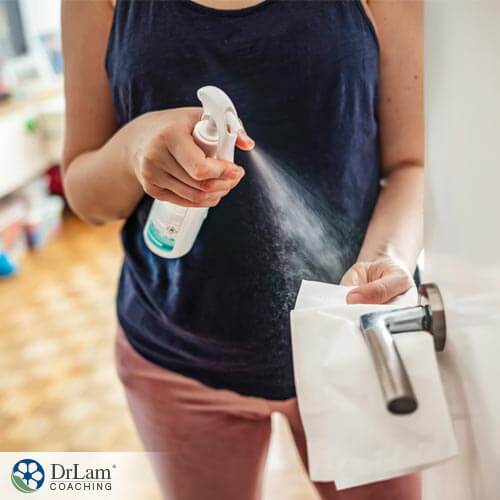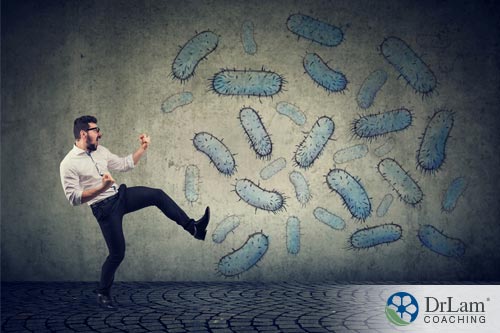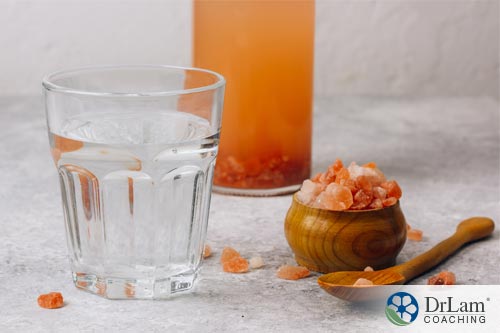 We live in a world full of germs and unwanted pathogens. To make sure everything gets as clean and sanitized as possible to prevent the spread of viruses, having an exceptional cleaner and sanitizer is necessary. It is likely that you’ve never heard of hypochlorous acid, but it is potentially the best of its kind for cleaning and sanitizing.
We live in a world full of germs and unwanted pathogens. To make sure everything gets as clean and sanitized as possible to prevent the spread of viruses, having an exceptional cleaner and sanitizer is necessary. It is likely that you’ve never heard of hypochlorous acid, but it is potentially the best of its kind for cleaning and sanitizing.
Everybody carries hypochlorous acid in their bodies. Your white blood cells make it as an aid in helping your immune system destroy or neutralize bacteria, fungi, and viruses. This very strong oxidant is approximately 80 to 200 times more effective than bleach as a disinfectant. At the same time, its composition renders it nontoxic.
Electrolyzed water, an industrial technology involved in green cleaning and sanitizing, contains this acid as its main active ingredient. This electrolyzed water, made when electricity passes through a mixture of salt and water, contains no harmful chemicals or fumes and leaves no residue.
Historically, this acid required membrane cell electrolysis to produce it. This type of procedure used high pressure to force saltwater through a membrane that separated it into two streams. One side was acidic, the other alkaline.
This technology costed a lot, required a lot of maintenance, and the resulting product proved unstable and lost its oxidation-reduction potential after a short time. Therefore, it was only useful for a short period of time.
Single-cell electrolysis is a new technology that has overcome those obstacles. Because single-cell electrolysis does not require high pressure to produce hypochlorous acid, maintenance issues decrease greatly. Likewise, a more stable product comes from this process, making it more useful for a longer period of time.
The technology used to make this acid has evolved over the years to the point where a home electrolysis system now allows you to make your own hypochlorous acid. Using water and table salt, you can produce a stable, safe, and effective sanitizing and cleaning agent.
Because hypochlorous acid carries no electrical charge, it more efficiently penetrates the protective barrier that surrounds pathogens such as bacteria and viruses. Therefore, it oxidizes the pathogens in a matter of seconds.
Research indicates that this acid carries 80% more bactericidal power than chlorine-containing disinfectants. In addition, it kills spores by invading them. Other disinfectants cannot kill spores. Research also shows hypochlorous acid only takes 30 seconds to effectively sterilize to a 99.99% level of sterilization. This includes epidemic infectious viruses.
Added to this, it does not produce irritating fumes. Likewise, it is safe to use around children, in kitchens, or in schools. Even babies' toys and bottles can be sanitized with this product because it leaves no residue.
 Because of this, it has many uses in your home.. You can use it to sanitize laundry without discoloration or damage. Even on personal items such as your toothbrush or razor, it can be used as a sanitizer.
Because of this, it has many uses in your home.. You can use it to sanitize laundry without discoloration or damage. Even on personal items such as your toothbrush or razor, it can be used as a sanitizer.
The gentleness of hypochlorous acid makes it very useful in hospitals and medical clinics. In fact, health facilities in various countries use it as a disinfectant. Its use has shown no toxicity, no residue left on surfaces, and no corrosiveness.. Veterinarians often use it in their practices. Also, it proves effective in removing biofilm.
Another use of hypochlorous acid is in water treatment. Water treatment professionals can increase the power of the acid to make it more efficient at killing pathogens in your water.
This natural cleaner and sanitizer carries virtually no risk of people developing allergies to it and no antibiotic resistance, making it safer to the public.
Because of this, hypochlorous acid can be considered an alternative to bleach, bath and tile cleaners, glass cleaners, carpet cleaners, and any multipurpose cleaner.
Research shows it effectively kills 99.9% of bacteria. Also, it is effective against fungi and viruses.
The strength of any disinfectant solution is commonly expressed in ppm (parts per million). This measurement is the mass of a chemical per unit volume of water. One ppm is equivalent to the absolute fractional amount multiplied by one million.
Therefore, in a chlorine disinfectant, one ppm is equal to 1 pound of chlorine in 1 million pounds of water. One million pounds of water is approximately 120,000 gallons. Converting to ounces, (1 pound = 16 ounces) 1 ounce of chlorine in 7,500 gallons equals 1 ppm.
The concentration of a sanitizing solution is a critical factor governing its efficacy. In the case of chlorine bleach, the 1997 FDA Model Food Code recommends a concentration of 25-100 ppm (parts per million) depending on the job to be done, the temperature of the water (75 to 100 degrees Fahrenheit), and the pH of the solution. The contact time should be 7 seconds or more.
It must be noted that hypochlorous acid is not the same as bleach of Clorox, which contains the active ingredient sodium hypochlorite. While they are both chlorine-based disinfectants, and they both sound similar, they have distinctly different properties. Most chlorine-based sanitizers contain 50-100 ppm. Household bleach usually contains 5.25% sodium hypochlorite. This is equal to approximately 50,000 ppm available chlorine. This is very strong, and that's why bleach is usually diluted before use. You can use a 10% dilution with water (1-part bleach and 9 parts water) to arrive at 5000 ppm strength, for example. For further dilution, use 1-part bleach and 99 parts water to get to 500 ppm available chlorine. This concentration can be compared to hot water sanitization which requires a temperature of at least 180 degrees Fahrenheit. Ammonia-based sanitizers usually require a 150-200 ppm concentration and 30 seconds contact time. Iodine based sanitizers require 12.5- 25 ppm.
Having an effective, non-toxic way to sanitize your environment is especially important when you are under chronic or severe stress and your body is more vulnerable to the effects of adrenal fatigue.
When stress hits your body, an automatic response activates. At the end of that response, your adrenal glands produce and release cortisol and other hormones to fight the effects of stress. If stress continues and increases in severity, your adrenals may not produce sufficient cortisol to keep up with demand. At this point, Adrenal Fatigue Syndrome (AFS) results.
At first, symptoms of this syndrome are vague and may not be picked up by your physician. Over time, they increase in severity and ultimately may lead to debilitation.
The NeuroEndoMetabolic (NEM) Stress Response is your body's global response to stress that it perceives as a threat to your survival. Made up of six circuits, each containing three organs or organ systems, the circuits of the NEM work together to help your body deal with stress and its results. Should the NEM stress response prove ineffective in dealing with stress, or if stress intensifies, dysfunction among the circuits can result. Symptoms coming from this dysfunction can be devastating to the body.
The Inflammation and Detoxification circuits of the NEM activate early in the process of dealing with stress. In your body, the hypochlorous acid - naturally produced by your white blood cells - works to boost your immune system’s ability to deal with pathogens.
Your immune system works closely as part of both the inflammation and detoxification circuits.
 A strong immune system leads to a properly working Inflammation circuit that produces sufficient inflammation to deal with injuries or damage caused by invading pathogens. Also, it prompts the inflammation to disappear when no longer needed.
A strong immune system leads to a properly working Inflammation circuit that produces sufficient inflammation to deal with injuries or damage caused by invading pathogens. Also, it prompts the inflammation to disappear when no longer needed.
Problems arise, however, when inflammation becomes chronic.
Even at a low level, chronic inflammation can bring on serious health problems. It can also become a source of stress on your body itself. Therefore, it increases the likelihood of AFS symptoms beginning or growing worse. Research shows it plays a major role in many, if not most, chronic conditions that affect the heart and circulatory system, joints, and even your brain.
When inflammation becomes chronic and a source of stress itself, this leads to the inflammation circuit working overtime. A state of imbalance results that leaves you vulnerable to acquiring different diseases. Also, it tends to speed up the aging process.
Once inflammation becomes systemic, affecting your entire body, it affects your ability to digest food properly. Therefore, you get less and less of the needed nutrients to keep your body healthy.
Some of the pathogens that can cause harm to your body come from the environment. Foods, the surfaces foods touch during processing, and the surfaces you touch on a daily basis all can serve as havens for pathogens of various kinds.
Therefore, the cleaner and more sanitized you can get all the surfaces in your home, the fewer of these pathogens you allow into your body. And with cleaner surfaces and fewer pathogens, you don’t add to the load your body already deals with. This makes a great difference when a person suffers from AFS.
At the same time as your immune system works to rid your body of pathogens, your Detoxification circuit works to get the dead pathogens and damaged or dead cells out of your body. In your detoxification process, your immune system destroys the pathogens, then the extracellular matrix (ECM) transports the remains to your liver for complete detoxification.
If your body is working under a tremendous load of pathogens, this process may become clogged. It must handle not only pathogens but also the ‘normal’ load of metabolites generated by normal processes of metabolism. Metabolites describe the by-products of metabolism. Some of these metabolites become active or reactive, interacting with other substances in the body and becoming toxic.
Some foods contain unwanted substances such as hormones and antibiotics fed to animals. Polluted air and unclean water also contain these unwanted substances. They enter the body and become metabolites. Too many of them become toxic to your body.
Working under an overload of pathogens and metabolites, the ECM gets backed up in its transport duties, especially when the liver becomes clogged with the extra load. This can lead to a situation in which your body becomes flooded with an overload of pathogens and metabolites. Such a condition then leads the immune system to become potentially hyperactive and generates a tremendous amount of inflammation. This can lead to the development of autoimmune conditions.
Keeping surfaces and foods as clean and sanitized as possible will decrease the amount of environmental pathogens that can potentially invade your body. Hypochlorous acid works wonders as a cleaner and sanitizer. Also, it does not promote toxicity or irritation. Lowering the likelihood of pathogens entering your body from the environment greatly benefits you if you suffer from AFS.
It is always important to note that adrenal fatigue sufferers are very sensitive to many compounds, so be wary even when using hypochlorous acid for the first time, as you might have a paradoxical reaction to it.
Hypochlorous acid can be purchased commercially in ready made spray bottles. These come in a variety of concentrations and uses ranges from being a sanitizer to ophthalmic solution. The use depends on the pH, the purity, and stability of the solution. Solution used from the generator is designed for sanitizing use and not for topical use. Pure HOCl is subject to natural decay over time. Ready-made formulas, therefore usually deploy stabilizing agents to ensure longer shelf life. These stabilizing agents may not be friendly to the body. Previously, the technology used to produce this acid required high pressure, a lot of maintenance, and produced an unstable product. However, improvements in this technology have allowed for home production of this acid.
 You can make this all-natural, safe, and environmentally-friendly sanitizing and disinfecting solution using breakthrough titanium electrolysis technology in your home. All you need are water, salt, and the generator. The ability to produce your own supply of hypochlorous acid at home is an excellent way to produce a supply of safe and non-toxic sanitizer. The HOCL Generator is the machine that enables this process. How the acid is dispersed into the environment is key to its effectiveness as well. Simply spraying hypochlorous acid into the air or on the surface of objects can sometimes result in droplets that are concentrated in certain areas while leaving other areas untouched. This generator is great because it covers 100% of the surface evenly and consistently. Always use an advanced ultra-fine particle spray spout that generates ultra-low velocity cool mist. This allows you to cover a widespread surface with even coverage, resulting in little wastage and no ‘empty spots’ for pathogens to survive in.
You can make this all-natural, safe, and environmentally-friendly sanitizing and disinfecting solution using breakthrough titanium electrolysis technology in your home. All you need are water, salt, and the generator. The ability to produce your own supply of hypochlorous acid at home is an excellent way to produce a supply of safe and non-toxic sanitizer. The HOCL Generator is the machine that enables this process. How the acid is dispersed into the environment is key to its effectiveness as well. Simply spraying hypochlorous acid into the air or on the surface of objects can sometimes result in droplets that are concentrated in certain areas while leaving other areas untouched. This generator is great because it covers 100% of the surface evenly and consistently. Always use an advanced ultra-fine particle spray spout that generates ultra-low velocity cool mist. This allows you to cover a widespread surface with even coverage, resulting in little wastage and no ‘empty spots’ for pathogens to survive in.
As mentioned, the device only requires salt and water. However, the type of salt and water you use does matter.
To create a household sanitizing solution that can be used every day around the house and on furniture, follow these simple steps.
Because this is a natural compound, there is a slow decay of potency with time. For best results, we recommend making a new batch of household sanitizing solution every 14 days and discarding the unused disinfectant after 14 days.
Store at room temperature in a dark location when not in use. The solution is biodegradable and environmentally safe. No special disposal considerations or handling precautions required. Rinse the HOCL Generator with water after use and air dry for storage.
You can purchase the HOCL Generator at Store.DrLam.com.
Hypochlorous acid works as an all-natural cleaner and sanitizer that is more effective than many, if not most, other cleaners and sanitizers. Your body uses it normally to help the immune system deal with invading pathogens. It is produced naturally by your white blood cells.
Clinical research and practice shows that it kills 99.9% of bacteria. Also, it is effective against fungi and viruses. As the active ingredient in electrolyzed water, industries use it to clean in an environmentally-friendly way.
Hypochlorous acid effectively penetrates the covering around pathogens to neutralize or destroy them. At the same time, it is completely safe and non-toxic.
Due to its non-toxic nature, its complete safety, and due to its amazing power to kill pathogens, this acid can bring great benefits to people who suffer from AFS. Ridding your home of extra pathogens will reduce the risk of you ingesting more pathogens from surfaces you touch.
© Copyright 2020 Michael Lam, M.D. All Rights Reserved.
Hypochlorous acid is a naturally-occurring product coming from your white blood cells. Normally it helps your immune system deal with invading pathogens. In addition, as a cleaner and sanitizer, it kills 99.9% of bacteria and is effective on fungi and viruses. It has no side effects.
